Do you use single-use plastics? We all have something plastic, and in fact, it’s almost hard not to see it in every area of your home, bathroom, garage, car, or refrigerator. It literally is everywhere.
Sometimes the Universe starts to nudge you in the direction you need to go. That’s what happened to me concerning hearing about Plastic. Yup, it sounds crazy, I know, but it happened.
First, I saw an article about plastic and recycling being a sham.
Then I came across Dr. Oz by chance or fate, discussing microplastics and how much we humans inadvertently consume every year. Roughly the amount of the size of a credit card. Wow! And WTH!
Later that same day, I saw a program on PBS about Plastic and its impact on the world. Lastly, I watched a Netflix documentary series named Broken and saw microplastics again.
I thought it was the last thing; it was obviously the Universe’s way of getting my attention to turn to this particular topic. As with all of my blog posts, I ask for guidance on what should be written next.
This was loud and clear. Four different programs about Plastic in less than two days! If that isn’t guidance, I don’t know what is.
What is even crazier is while writing this post, I went outside to take a little break and play with my daughter and dog. I stood there and glanced over and noticed a piece of something blowing in the wind in my crepe myrtle tree. Its leaves and flowers have come and gone as it’s wintertime. So I can see through all the branches. What is that?
A bird’s nest is made with plastic intertwined with twigs. There was one big piece of plastic flapping in the wind, and that’s what I saw. This is so crazy and only drove home the importance of everything I just read, watched, and now witnessed firsthand. Not to mention the impact on nature is genuinely happening in your own backyard.
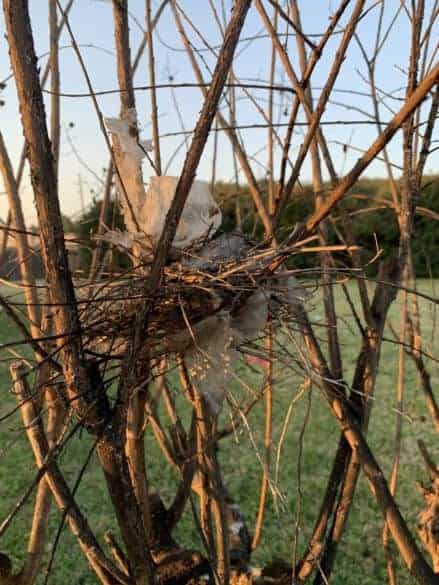
Single-Use Plastic Items
What Is Single-Use Plastic?
Disposable plastic or use it once and then throw it away type products. This includes
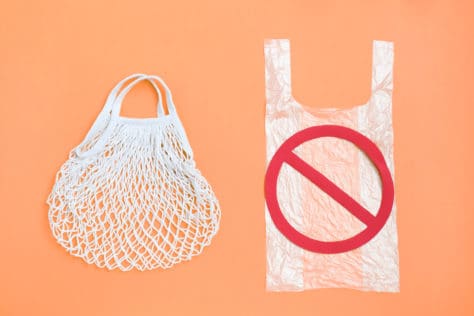
Plastic bags – grocery bags
Straws
Plastic Water bottles
Container Cups
Plastic Cutlery
Food packaging
How Can One Thing Be so Impactful?
Simply it doesn’t ever really go away. It will break down into smaller and smaller bits, but it will not biodegrade like paper. It will be here for possibly another 1,000 years. So that straw, plastic bag, take-out containers you just used will still be here, in some form, in 1,000 years.
YOU READ THAT RIGHT 1000 YEARS!!
The plastic bags I keep talking about, you know the ones you carry your groceries in, take 20 years to break down. Again, break down only, not biodegrade or decompose completely. It’ll be here just in smaller pieces, also known as microplastic.
That plastic water bottle you just drank out of will discuss the chemicals you’re also consuming later, will take 450 years or more to break down.
Disposable diapers take 550 years to decompose. Wow, this is the one thing I did use with both of my children. It didn’t dawn on me about the diapers being plastic and how they can impact the environment. The baby bottles, for me, were the bigger problem at that time. I know now, and that’s what we’re aiming out here…knowing better to do better.
How Long Does Paper Take to Decompose?
2-6 weeks in a landfill!
Impact on Ocean and Marine Animals
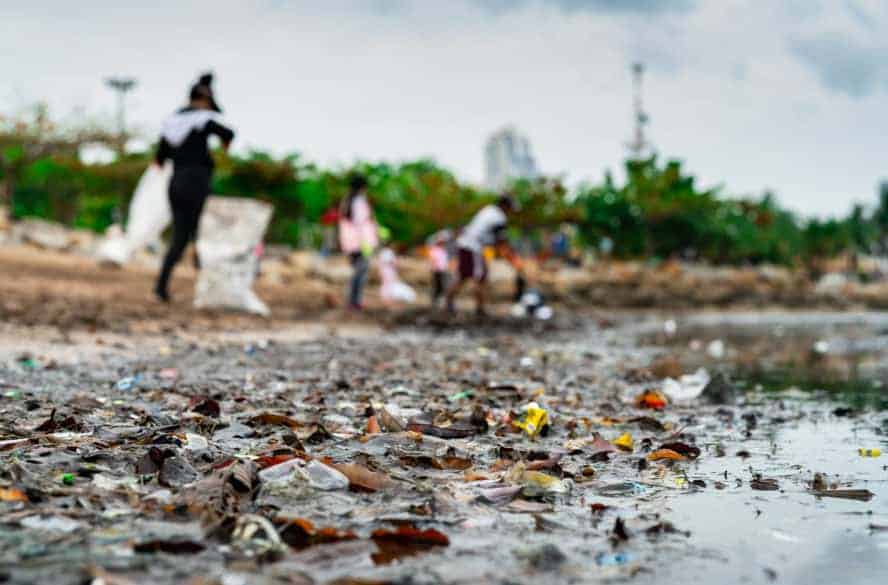
AN ESTIMATED 8 MILLION METRIC TONS OF PLASTIC ENTER OUR OCEANS EVERY YEAR! EVERY YEAR!
The documentary A Plastic Ocean shows how much plastic, not food or fish, that birds who feed on the ocean life have in the stomachs. They show birds being examined after death and physically removing hand fulls of plastic chard pieces from their stomachs!! Hand fulls!!! This is so disturbing and sad to see how they are impacted by what we are doing or not doing.
It’s estimated that nine out of every 10 seabirds on the planet has pieces of plastic in their bellies, while albatross and shearwater are regularly found with thousands of plastic bits caught in their stomachs, eventually killing the animals.
Greenmatter.com
Whales and sea turtles being killed by having eaten large amounts of plastic because they cannot decipher if it’s food or not. If it’s in the ocean water floating, then it must be food. As a huge animal lover of all kinds, this was very troubling for me to see. Again, knowing is caring, and it definitely opens your eyes to wanting to help.
You see how the plastic straw you use is detrimental to the sea turtles. They had to remove a lodged straw from the sea turtle’s nostril. It was horrible and unnecessary. Yet here it is a problem and a reality.
Great Pacific Garbage Patch/Pacific Trash Vortex
It’s twice the size of France and is located in the North Pacific Ocean.
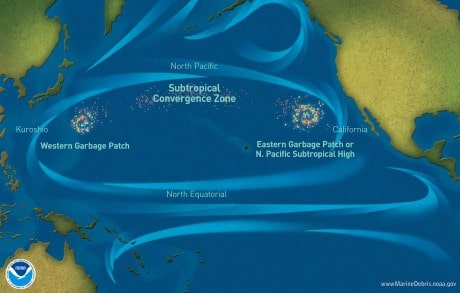
What Is It Exactly?
Its plastic waste broken down in the ocean gets swept into the convergence zone is so large that it pushes the waste debris to Western Garbage Patch, Eastern Garbage patch, or the Western Garbage Patch.
Garbage patches are large areas of the ocean where litter, fishing gear, and other debris – known as marine debris – collects. They are formed by rotating ocean currents called “gyres.” You can think of them as big whirlpools that pull objects in. The gyres pull debris into one location, often the gyre’s center, forming “patches.”
NOAA Marine Debris Program
There are several of these trash vortexes in our oceans and seas. There are 5, including 2 in the Atlantic, 2 in the Pacific, and 1 in the Indian Ocean.
You still don’t know how that plastic water bottle you used pertains to this issue? National Geographic gives a specific route on how your plastic water bottles play a role in the Garbage Patch in our oceans.
A plastic water bottle discarded off the coast of California, for instance, takes the California Current south toward Mexico. There, it may catch the North Equatorial Current, which crosses the vast Pacific. Near the coast of Japan, the bottle may travel north on the powerful Kuroshiro Current. Finally, the bottle travels westward on the North Pacific Current. The gently rolling vortexes of the Eastern and Western Garbage Patches gradually draw in the bottle.”
National Geographic
These patches contain microplastics. Which is the process of the breaking down of these plastics (your water bottle) into smaller and smaller plastic called microplastics.
What Is the Alternative to Plastic Bottles?
Use stainless steel and there are glass bottles that are better alternatives not to mention reusable.
Even swap out baby plastic bottles out for glass bottles. I used glass bottles for my daughters, and it is not as worrisome as it appears to be. Over the course of several years, we only broke one, and that was because it slipped out of my hand in the kitchen. No babies were injured. While we did use glass bottles, we did have plastic bottles that we’re used to most of the time.
What Is the Alternative to Grocery Bags?
Reusable bags that yes you must take with you to the store each time, rather than have your groceries sacked in plastic bags. Trust me; I’m struggling with being able to do this as my next big swap out. I just purchased these bags and will use them on the next trip to the store.
Did You Know There Are Different Kinds of Plastic and They’re Not All Recyclable?
Polyethylene Terephthalate (PET or PETE or Polyester)
You use it as a plastic water bottle or single-use bottles.
High-Density Polyethylene (HDPE)
You know this as your bottles for your household cleaners and laundry detergent jugs, shampoo bottles, milk jugs, butter and yogurt tubs (even those little guys, you just don’t think about this stuff, at least I haven’t until now).
Polyvinyl Chloride (PVC)
Used in construction as piping or siding, health care as tubing, insulation of wires and cables and more.
Low-Density Polyethylene (LDPE)
Your plastic bags again.
You use it as a squeezable bottle, plastic wrap, six-pack rings, juice/milk cartons, packaging for computer hardware, kids’ playground slides.
PolyproPolystyrene (PS)
You use it as Styrofoam, solo cups, packaging peanuts, take out containers, plastic cutlery, smoke detectors.
Polypropylene (PP)
You use it as plastic hinges, kitchen utensils, cutting boards, car batteries, food storage containers, outdoor rugs and more.
Bisphenol A (BPA)
You use it in plastic bottles, baby bottles, internal coating of canned foods, and more.
Polycarbonate (PC)
It hasn’t been used as much in recent years due to it being associated with bisphenol A (BPA).
Products Stating BPA Free
You see BPA free and think you’re making the safer choice. However, just because a plastic bottle is BPA-free doesn’t mean it is free of other harmful chemicals that you will be ingesting. This is only one of the many chemicals used to manufacture that plastic bottle. So sure, BPA may not be in your plastic bottle, but everything else is still harmful.
How Can You Help?
Stop Using Single-use plastics. Think reusable instead of disposable.
Is this going to require some effort on your part, of course? What doesn’t? The fact is, we must change the way we see plastic products. As stated in the documentary A Plastic Ocean (Netflix) says at the end, “from knowing comes caring and from caring comes change.”
First, we must know what our plastic waste is doing to the world, cities, communities, and families who live there to begin to understand how you and I directly impact this problem. It was sincerely alarming to see how people live where the ocean washes up plastic waste and its impact on their health.
People getting cancer who live in these environments from constantly inhaling plastic and toxic chemicals. Their streets are literally paths of plastic trash. Everywhere you look, you see mounds and endless plastic hills. Kids playing on top of this trash, which is all plastic.
All I can think is how horrible and what can I do?
Everything happens for a reason. I truly, completely, and wholeheartedly believe this. There is a reason that I saw program after program about Plastics and how it’s impacting our health and living space, including oceans and wildlife. Perhaps so I could share it here with you and spread the word.
One solution to this environmental disaster is biodegradable plastic. There are two types currently on the market — plant-based hydro-biodegradable plastic and petroleum-based oxo-biodegradable plastic. In the former category, polylactic acid (PLA), a plastic made from corn, tops the list as the most talked-about alternative.
Please Don’t Get Discouraged
You can easily become overwhelmed by all this information and processing just how much plastic we all use. More troubling is its impact on our environment, the air, the ocean, marine life, and our lives.
If you watch all of these programs as I did, you may feel an urgency to do your part. These programs don’t seem to offer a direct solution which makes me think that we are all part of the solution.
From manufacturers to consumers. Pointing blame gets us nowhere.
We all play a role, and the focus should be bringing more awareness to the masses and forcing change. We can’t wait around and expect someone else to take care of a problem we all created.
Blaming anyone or anyone industry won’t help. We’ve all contributed at some point in time. Therefore, we all have to contribute to the solutions. Small changes bring big changes.
MAKE A CHANGE
I ask you to make a change and do a small swap out for plastic in your home. I’ve been doing so little by little over time. My biggest step is to remove plastic bags from our grocery trips. We purchased these bags to use for our next trip this weekend.
Once you make a swap out to a non-plastic alternative, then move on to another swap. I prefer to use that particular item until it’s gone before swapping out. This gives me time to find an alternative and to use up what we have first.
You may read this and want to swap something out right away. And that is great news!! That would make me so happy. Start with one thing you can easily swap out. So you’re more likely to stick to it and then pick something else to swap out.
Even a small change is a change. And it counts. Your energy that goes into making that change goes out into the world can help inspire someone else to do the same. That is what we want to do, inspire others to make the change to improve our environment and, in turn, the world and all who live here.
The ripple effects of change will be felt for some time. You have to start the ripple to create a big wave of change in the future.
Some Items I Swapped out for More Eco-Friendly Options over the Years
- Wedding Invitations were biodegradable and contained flower seeds so if planted flowers would grow.
- Glass baby bottles instead of plastic
- Bamboo and stainless steel straws rather than plastic and smoothie straws
- Silverware rather than plastic cutlery
- Stainless steel reusable mug for water and beverages
- Homemade detergent and store in a metal container
- Vinegar in a glass bottle for fabric softener
- wool dryer balls for dryer sheets
- Stopped using paper plates and use regular glass plates
- Stopped using single-use plastic cups
- Reusing plastic bottle dispensers for other homemade products
- Stopped purchasing water bottles and use filtered water
- Use glass food storage containers instead of plastic storage containers (I use my old Corningware dishes for storage).
- Use silicone sheets for baking instead of aluminum foil – still working on my husband to find an alternative to using it for grilling.
- Reusable shopping bags for groceries and other stores
- Use cloth towels instead of paper towels
- Use wood cooking utensils rather than plastic, try Spurtles
We still have a way to go, but for now, we’re focusing on plastic bags as the next swap. Do what works for you first, then build from there. There is no wrong or right way to make the changes. The point is to make a change. Reduce, Reuse, Recycle.
There is so much more to tackle this issue that it’s nearly impossible to do in on the post. We will continue on this journey by visiting recycling next time.
UPDATE 2/25/21
Perhaps one of the most important ways to stop using single-use plastics is by teaching the next generation about single-use plastics.
My daughter now knows about single-use plastics and the impact on the environment through her Girl Scouts and my teachings. The first time she pointed out something that is not eco-friendly in the house, she pointed and said, “that ends up in the ocean, you know.”
I was so proud that this is instilled in her and made her aware of what hurts our environment and animals. Our children truly do learn from us.
I wish you peace and guidance on your journey. Take care and be well. Swap one plastic item out!
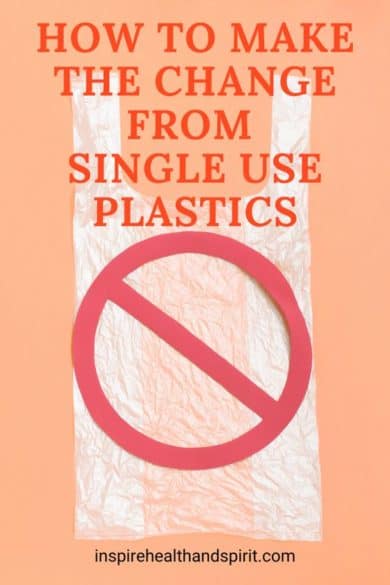
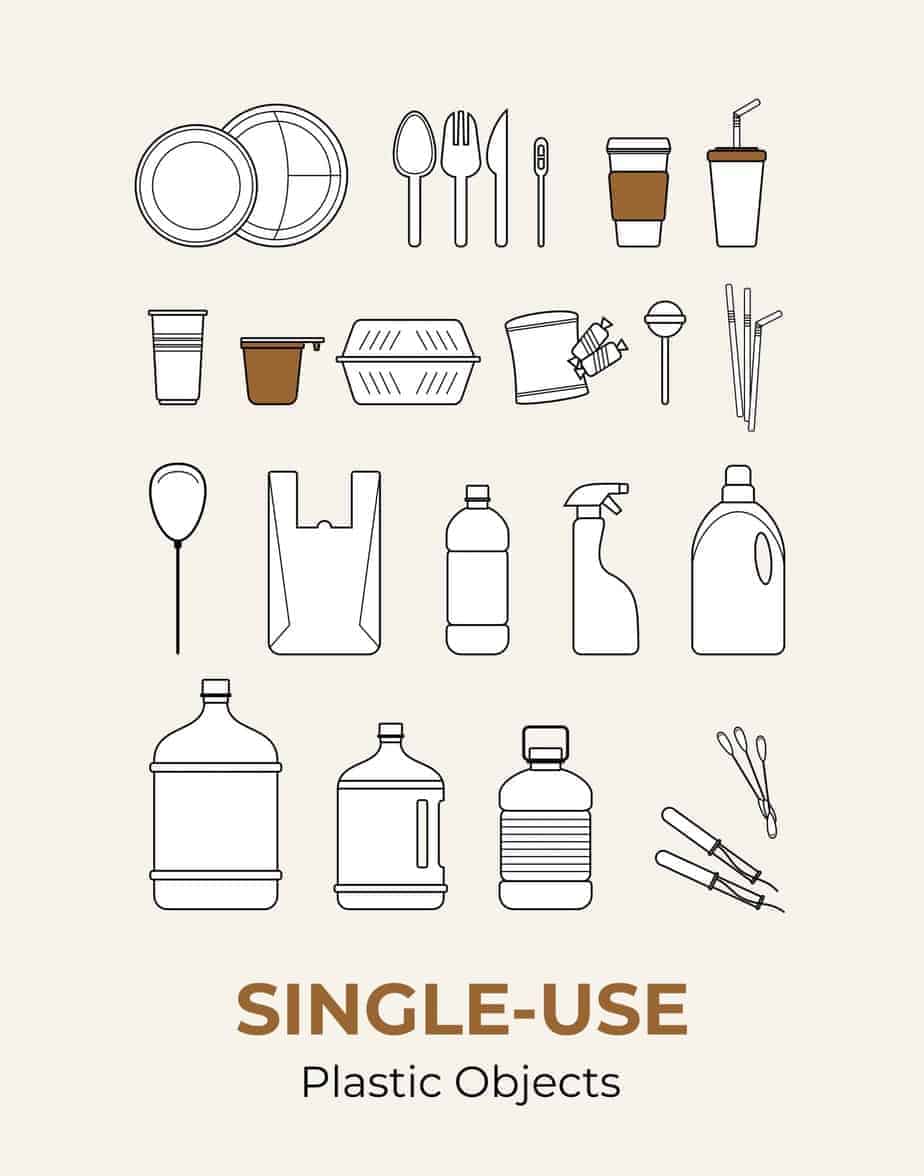


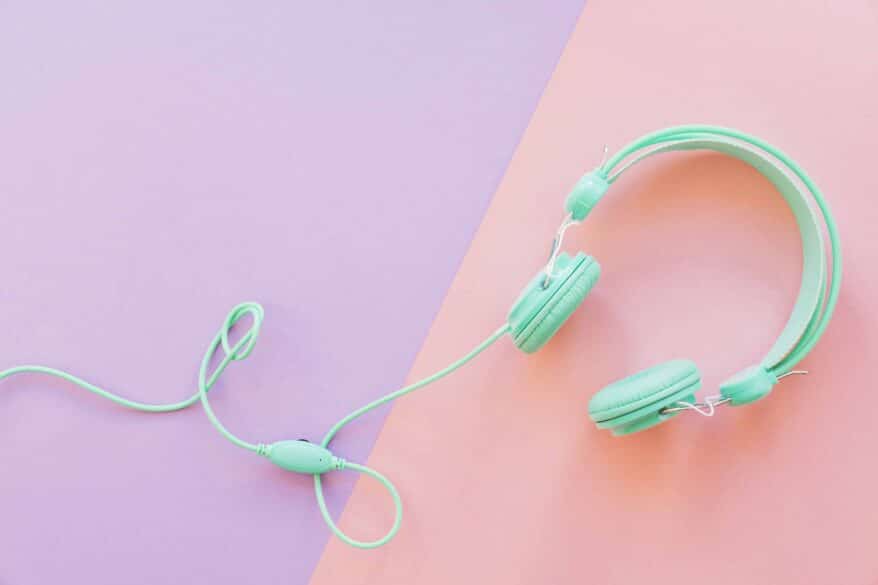

Thank you for spreading the word about the nightmare that the plastic is.
Europe is doing quite a lot now to cut down on single use plastic, e.g. you are encouraged to bring your own flask to Starbucks or any other coffee shop instead of buying the drink in a disposable cup. You get some discount when you don’t use the disposable cup. You can also drink in the coffee shop and then you are given a china cup which is later washed and reused – something I did not see in NYC when I went there this year.
We can definitely cut down on the plastic – but as you say, it takes commitment and time, and will to do it.
Thank you for your comment. I agree Europe is ahead of the US when it comes to this. I truly hope that we will catch up soon and start making the necessary changes. Awareness is the key. Thanks for doing your part too, it’s encouraging.